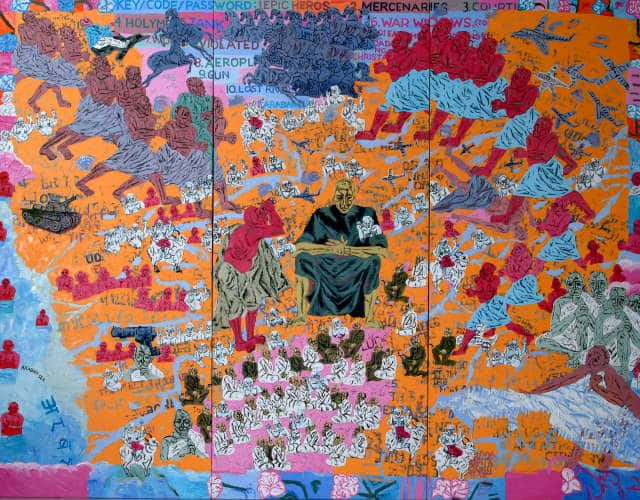Arpita Singh, the 1937-born painter known for her elaborate surrealistic narratives, is one of the participating artists in the fifth Kochi-Muziris Biennale, which is due to open in December this year. Singh has a definitive place in the history of Indian modern and contemporary art. Her presence in the modernism of post-independence India is significant because she was among many women artists, such as Nalini Malani, Madhvi Parekh and Nilima Sheikh, who began creating an independent trajectory for themselves in the male-dominated art scene, from the 1960s and 70s. The rise of women artists in newly independent India also has an international resonance because it coincided with the women’s rights movement, mostly in the United States. She began her career as an artist around the time Indian arts witnessed a renewed gravitation towards narrative-figuration, during the second half of the 20th century. She is celebrated for her lifelong commitment to the medium of painting, when other artists of her generation diversified into other media, such as video, installation, and mixed media. A painter for the past six decades, she has devoted herself to the style of figuration, while working with abstraction briefly. Born in West Bengal, Singh was exposed to creative expression at an early stage in her life, through literature, mythology and art. These early life experiences explain her interest in storytelling and fable-like narratives. As a schoolgirl, she is believed to have shown a flair towards drawing and painting. Her formal education in fine arts began in the 1950s, at the Delhi Polytechnic, where she studied under artists as diverse as Biren De, BC Sanyal, Sailoz Mookherjea, and Jaya Appasamy. Most of these artists are known for their bent towards figuration, which is also a defining quality of Singh’s practice, although she worked out her own language of a dense layering of patterns and narratives, with many of them showing women as the looming presence. While working at the Weaver’s Service Centre, during the 1960s, she worked closely with embroideries and fabrics, especially kantha — an experience that has led critics to draw parallels with the intricate colour- and form-based patterns of her paintings. Letters, numbers, symbols, human figures, flowers, guns overlap and enmesh in each other, like a closely woven fabric. Using these disparate elements, Singh builds up her narratives with scenes of mythology, war, domestic life, parties, social gatherings, intimacy, death, sickness, cityscapes, and more. Through her deliberately unsophisticated style of storytelling, she creates distorted or fragmented stories, with plots and sub-plots, that speak to an equally fragile and disturbed modern life. [caption id=“attachment_8713691” align=“alignnone” width=“640”]  Watever is Here, by Arpita Singh. 2003 Oil on canvas. Courtesy - Kiran Nadar Museum of Art[/caption] The artist’s paramount engagement is the human figure. In most of her compositions, what stands out is the woman in multiple avatars: solitary, ageing, dying, often in the nude, saintly, and heroic in the manner of a “Devi”, with many hands. The latter can be seen as a contemporary adaptation of Abanindranath Tagore’s iconic nationalist-era painting Bharat Mata (circa 1905). Contrary to Tagore’s serene Mother India figure, Arpita Singh’s Devi is about to shoot a man with a gun, while carrying fruits in her other hands. The imagery not only represents the artist’s preoccupations with feminist themes, but also stands out for its subversiveness, couched in (deceptively) playful human figures, patterns and colours. Her human figures appear ambiguous in their expressions and demeanour, living as they are in a world of grey realities, where there are no clear distinctions between right and wrong. The jagged lines drawn over the faces and bodies of the ghostly men and women invoke fear and horror. The artist creates these sights of hyper-realism through an adept use of colour, rendered in vibrant pinks, blues, greens, which afford a charged quality to the otherwise grim narratives of war and remorse, death and sickness, and loneliness and despair. The application of thick paints of colour on the canvas has an impasto feel to it. The spontaneous and prominent brushstrokes loosely recall the swirling movements of colour in Vincent Van Gogh’s Starry Night. Her black-and-white abstractions, on the other hand, retain the dense layering of her paintings, with a thick web of lines and other forms of mark-making. Her small-format drawings and watercolours have a simplicity of line and colour. The decluttered nature of these compositions suggest they are preparatory works for the bigger paintings, although the thread of storytelling runs through the smaller works as well. The recourse to storytelling is also an important part of the curatorial theme of the forthcoming Kochi Biennale, which is titled In Our Veins Flow Ink and Fire. Put simply, the Singaporean artist Shubigi Rao’s curatorial essay reflects the anxieties of our polarised and authoritarian times, while calling out artists to show solidarity, through the “redemptive power” of their practice, and speak up against censorship and the imposition of singular narrative. “To envision this biennale as a persistent yet unpredictable murmuration in the face of capriciousness and volatility comes from my unshakeable conviction in the power of storytelling as strategy, of the transgressive potency of ink, and transformative fire of satire and humour,” writes Rao in the essay, which is available on Kochi Biennale Foundation website. It will be interesting to see how Arpita Singh’s own style of storytelling features in the biennale, which Rao refers to as “a bulwark against despair”. While there is no visible trace of joy in Arpita Singh’s paintings, the redemptive quality of her work may lie in its very playfulness that makes life and living more appealing than what it is. Banner image: Artist Arpita Singh. Courtesy - Kiran Nadar Museum of Art
Through her deliberately unsophisticated style of storytelling, she creates distorted or fragmented stories, with plots and sub-plots, that speak to an equally fragile and disturbed modern life.
Advertisement
End of Article


)
)
)
)
)
)
)
)
)



